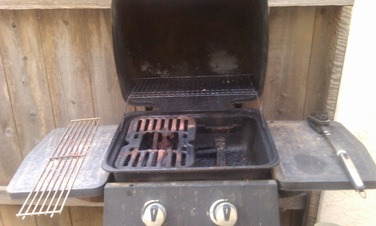 Raw footage. No Photoshopping involved.
Raw footage. No Photoshopping involved. It has sat uncovered through two rainy winters. My special lady won't let me cover it with a three-dollar blue tarp because she doesn't want to have to look at a blue tarp in her yard. She said she wanted to buy a regular, kind of olivey-colored grill cover for it for aesthetic reasons. She said this, but she didn't follow through on it.
Consequently, the grill has been losing its battle with rain and the atmosphere. It is now just a heap of rust out of which a raw flame can be coaxed. When I need to grill, here's the process I follow:
I turn on the gas and light the grill. This is the most fraught part of the operation, because the Little Clicky Thing That Lights the Grill has been useless for longer than Paris Hilton. I currently have an extended lighter, which makes the ignition process safer than other methods I have used in the past to avoid the unpleasant smell of burnt knuckle hair, like lighting some newspaper and thrusting it towards the burner, or merely throwing matches at it. This last method works sometimes because the burner, which once consisted of a solid, shiny metal pipe with little homes punched in it at disciplined intervals, out of which flames would obediently pop, has long since turned to a corroded half-pipe from which irregular tongues of fire twist and leap.
Next, the grill has to be heated, so that it can be cleaned and sterilized. The cleaning consists of a few desultory scrapes with the wire brush pictured above, a tool which is racing the grill to achieve a state of utter decomposition. This knocks the few remaining fragments of the piece of meat I barbecued last off the grill onto the patio, making the dog's day. Then I just let the thing heat up to kill all remaining microbial life. Really, it's safe. I figure anything that can survive 600 degrees and still kill me would have crawled upstairs while I was sleeping and done so long ago.
Often, while the closed grill is heating up, a dramatic jet of flame shoots out one or more of the holes in the side, making it look from a distance like an astronomical wonder being photographed by the Hubble Space Telescope. These ancillary flames threaten to ignite my neighbor's wooden fence at times, but so far she has ignored my suggestion that she move her fence.
Now I'm ready to cook. The eternal question for any griller is whether to sear the meat quickly on the grills themselves or to cook it slowly on the hanging rack? I have solved this dilemma for myself by letting the grills oxidize more or less completely. I have thrown away one, on the principle that if you have two things that are useless and disgusting, the prudent thing is just to discard one of them. Otherwise I wouldn't have any hot filthy metal on which to burn my hand if a food item were to fall off the rack and I felt the need to quickly pluck it from the flames.
I am not one of those grillers who need to stare at his food while it cooks, spatula in hand, ready to flip and shove innocent meat items brutally around in the flames. I close the lid and enjoy an adult beverage while I cook. The state of the grilling can easily be ascertained by the color of the smoke arising form the grill. If it's light and fragrant, the color of we've-elected-a-Pope smoke, all is well. If it turns a more somber hue, you'd better lift the lid and let it cool a tad. If all of a sudden you glance over and see, while you were involved watching your baseball team score six runs in one long and enjoyable inning, the smoke has turned black and fulminating, don't even bother opening the lid.
Turn off the gas, apologize to your neighbor and order Chinese.












 RSS Feed
RSS Feed











